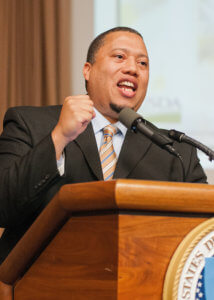 By Dan Gephart, April 21, 2020
By Dan Gephart, April 21, 2020
For a dozen or so years, I was a regular attendee at the EXCEL Conference, put on annually by the Equal Employment Opportunity Commission. I’m an introvert, so conferences could be a challenge for me. But I always felt at ease at EXCEL once I saw Dexter Brooks and his beaming smile walking down the hallway toward registration.
You’d be hard-pressed to find a better person to fill the role that Dexter performs at EEOC, where he is associate director of the Federal Sector Programs Office within the Office of Federal Operations. The SES-er leads FSP’s efforts to help agencies develop strategies to prevent discrimination. Dexter knows EEO law top to bottom, and he has a deep insider’s understanding of how EEO plays out at federal agencies. He is also an effective and engaging presenter, able to convey his EEO knowledge in practical and understandable bites.
FELTG caught up with Dexter before the country was turned upside down by the COVID-19 pandemic. We wanted to hear what OFO’s approach was to cases involving sexual orientation and gender identity as we await the Supreme Court’s ruling on Altitude Express, Inc. v. Zarda, Bostock v. Clayton County, and R.G. & G.R. Harris Funeral Homes v. EEOC. The combined cases raise the issue of whether Title VII’s protections against sex discrimination prohibit discrimination on the basis of sexual orientation and gender identity. The ruling is expected later this term.
The agency deferred on the question, not wanting to get ahead of any decision coming out of the Supreme Court. Understood. So we turned our attention to discrimination trends in the federal workplace.
DG: In what areas do agencies need the most training help?
DB: Based upon Federal Sector Programs’ complaints data collected from federal agencies, EEOC’s Appellate Review Programs’ findings of discrimination and procedural reversals, and FSP’s outreach and technical assistance to agencies, it appears that agencies are most in need of training on retaliation/reprisal, reasonable accommodation, non-sexual harassment, properly identifying and framing hostile environment harassment claims, identifying and resolving conflicts of interest issues that arise during the administrative EEO complaints process, and barrier analysis.
DG: It’s been a few years now since the agency’s report on harassment, and the sharp increase of sexual harassment complaints prompted partly by the #MeToo movement. What trends are you seeing in terms of harassment complaints? And have you noticed any considerable changes in how agencies are training their employees on harassment?
DB: Between fiscal years 2012 and 2018, federal agency sexual harassment complaints increased by about 1 percent, with a total of 3.1 percent of all complaints alleging sexual harassment in 2012 compared to about 4.4 percent of all complaints alleging sexual harassment in 2018.
After the issuance of the EEOC harassment report, EEOC developed new training classes for employees and managers on creating and maintaining a respectful workplace. These classes teach employees how to create a culture of respect using bystander intervention techniques and instruct managers how to identify and address uncivil behavior before it rises to the level of harassment. These modules are focused on proactive prevention rather than the traditional legal/compliance modules that typically had been the centerpiece of anti-harassment training. The demand for this type of training in the federal sector has been robust and has increased each year since the training’s 2017 rollout.
This is consistent with information FSP has received from agencies during outreach, which revealed agencies are not limiting their anti-harassment efforts to mandatory compliance training but are adding to their training modules on topics such as cultural awareness and civility.
DG: The workplace is as divisive as it has ever been. Is that being reflected in the number and type of claims you are seeing?
DB: Generally, the rate of counselings and complaints have seen a spike since fiscal year 2014, reaching a peak in fiscal year 2018 at 37,042 counselings — an 11 percent increase since fiscal year 2014. This is fairly consistent across all bases as of fiscal year 2018. Complaints also reached their highest level since fiscal year 2014 at 15,578 — an 8 percent increase. This increase appears to be across all bases, as the proportion of complaints filed by statute has remained consistent during this same time period, with Title VII comprising about 56 percent of all complaints, followed by ADEA at 22 percent, Rehabilitation Act at 21 percent, EPA at .48 percent and GINA at .42 percent.
DG: How is the EEOC doing on the backlog of cases over 500 days old? How long is a typical EEOC appeal from the time it’s received until the time it’s issued?
DB: Currently, [the Appellate Review Program] has 124 pending cases over 500 days old. The average processing time for an appeal is approximately 312 days. By comparison, in FY 2019, the average processing time was 399 days.
[Editor’s note: We will cover everything EEO-related during FELTG’s popular EEOC Law Week, which has been rescheduled for August 10-14, 2020 in Washington, DC.] [email protected]

